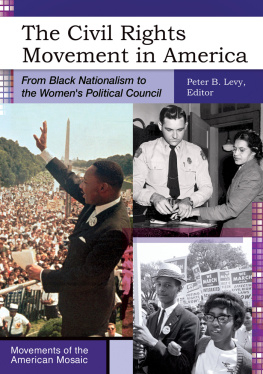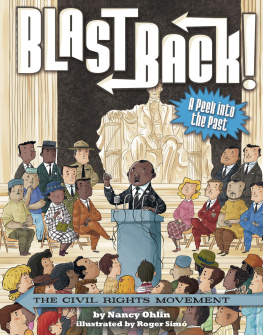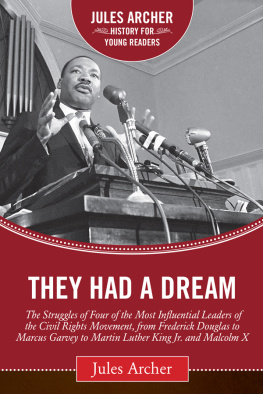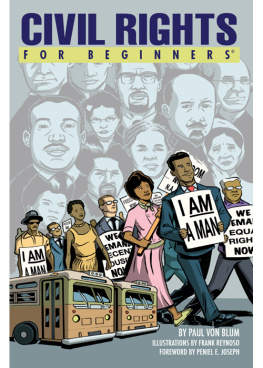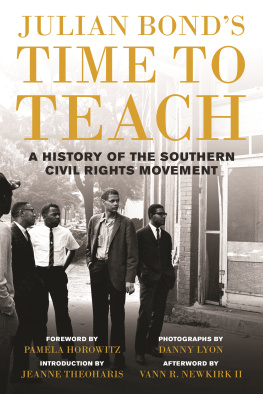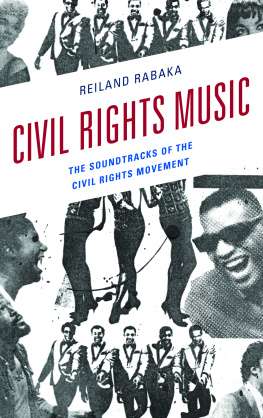THE CIVIL RIGHTS MOVEMENT IN AMERICA
THE CIVIL RIGHTS MOVEMENT IN AMERICA
The Civil Rights Movement in America
Essays by
DAVID LEVERING LEWIS
CLAYBORNE CARSON
NANCY J. WEISS
JOHN DITTMER
CHARLES V. HAMILTON
WILLIAM H. CHAFE
Edited by
CHARLES W. EAGLES

This volume has been sponsored by the
CENTER FOR THE STUDY OF SOUTHERN CULTURE
at the University of Mississippi.
Copyright 1986 by the
University Press of Mississippi
All rights reserved
Manufactured in the United States of America
The paper in this book meets the guidelines for permanence and durability of the Committee on Production Guidelines for Book Longevity of the Council on Library Resources.
Print-on-Demand Edition.
Library of Congress Cataloging-in-Publication Data
The Civil rights movement in America.
Bibliography: p.
Includes index.
1. Afro-AmericansCivil rights. 2. United States
Race relations. I. Lewis, David L. II. Eagles,
Charles W.
E185.615.C585 1986 323.1196073 865665
ISBN 0-87805-297-6 (alk. paper)
ISBN 0-87805-298-4 (pbk.: alk. paper)
Contents
DAVID LEVERING LEWIS
CLAYBORNE CARSON Comment: Steven F. Lawson
NANCY J. WEISS Comment: David J. Garrow
JOHN DITTMER Comment: Neil R. McMillen
CHARLES V. HAMILTON Comment: Mark V. Tushnet
WILLIAM H. CHAFE Comment: J. Mills Thornton III
Acknowledgments
The symposium on the civil Rights Movement took place at the University of Mississippi on October 24, 1985, under the sponsorship of the Department of History and the Center for the Study of Southern Culture. A number of individuals who contributed their time and effort warrant special recognition.
Dr. Cora Norman and the Mississippi Committee for the Humanities provided essential financial support. Their continuing interest in and assistance to the symposium series are greatly appreciated. Similarly, the National Endowment for the Humanities gave a crucial grant through its Division of Research Programs.
Without the conscientious efforts of the participants, the symposium could not have succeeded. Their contributions equalled the high standards evident in their own scholarship; moreover, the papers and commentaries sparked considerable discussion.
Chancellor R. Gerald Turner and Vice Chancellor Morris L. Marx were kind to address briefly the evening sessions of the symposium, and former Chancellor Porter L. Fortune, Jr., demonstrated his enduring interest by attending a number of sessions. The Department of History and the Southern Center are grateful for their support of the symposium.
Charles R. Wilson, director of the previous symposium, was a constant source of information and good advice; and Frederick E. Laurenzo, chairman of the Department of History, answered many questions, solved numerous problems, and handled innumerable last minute details. Sheila Skemp and Harry P. Owens helped at a particularly difficult time, and James J. Cooke did a fine job with what has become his annual duty. The departmental secretary, Susan Pettis, and her student assistant, Amanda Cook, worked with their usual skill, dispatch, and cheerfulness. At the Southern Center, Martha Doyel and Sarah Dixon assisted with many administrative problems. Ann J. Abadie, along with Mary Betsy Bellande of the University Development Office, helped with the submission of grant proposals.
The person indispensable for the success of the symposium was my wife, Brenda. Her ideas and enthusiasm, her confidence and support made it possible. Our son, Daniel, met the participants and attended several sessions, even though he could not have understood their significance. More important, he had a good time and added to the enjoyment of others, especially his parents.
Introduction
Twenty-three years after James Meredith enrolled at the University of Mississippi, eleven noted scholars came to the University to discuss, examine, and analyze the Civil Rights Movement. Representing the disciplines of history, political science, and the law, they participated in the eleventh annual Chancellors Symposium on Southern History. Their papers and the commentaries on them contribute to a clearer perception of what caused and motivated the Civil Rights Movement, how it functioned, the changes that occurred within it, and its accomplishments and shortcomings.
The Civil Rights Movement warrants such extensive examination because it had a profound effect on the modern South and the entire nation. From the United States Supreme Courts decision in Brown v. Board of Education in 1954 to the death of Martin Luther King, Jr., in 1968 and the waning of the movement in the late 1960s and early 1970s, blacks and whites engaged in a monumental struggle for black equality. The movement, of course, had antecedents to the Brown decision and has involved significant work since the 1960s, but the most important changes in racial segregation and discrimination occurred in the intervening decade and a half. Though the Civil Rights Movement did not solve what Gunnar Myrdal termed the American dilemma, it did alter the status of blacks in southern society; it so changed relations between the races that C. Vann Woodward has called it the second reconstruction.
Many Americans, but perhaps especially southerners, can certainly remember events and people from the days of the Civil Rights Movement, but their understanding of the movement remains in most cases limited to their own recollections of news accounts, their observations in their own local communities, and stories they have since heard about the movement. For many others, particularly the young, the Civil Rights Movement is not a memory but history, and they know little about it. Only in the last decade have scholars begun to study the Civil Rights Movement intensively and to provide the basis for a greater understanding of it.
The following six essays and the commentaries do not provide a comprehensive history of the Civil Rights Movement but instead analyze a few important aspects of it ranging from the movements leadership to the movement in a single significant state. The authors are all scholars who have made outstanding contributions to the study of the movement.
The opening essay by David Levering Lewis seeks to explain the sources of the movement by boldly suggesting that political demographics may truly be said to be racial destiny. In a cogent review of events from the 1930s to the early 1950s, he emphasizes the migration of blacks from the South to the urban North as a prerequisite for the movement. No commentary follows Lewiss paper because illness prevented the appearance of both the scheduled commentator and a substitute. Comments from the audience, however, proposed that Lewis paid insufficient attention to changes occurring within the South among blacks who remained in the region. He had, several indicated, neglected the indigenous southern origins of the movement.
In the second paper, Clayborne Carson also stresses the need to study the mass activism in hundreds of local communities. He calls for shifting the focus of inquiry from the large organizations, professional reformers and politicians of a national civil rights movement to the black freedom struggle growing out of a myriad of issues at the local level. Questioning the importance of institutionalized strategies and tactics and the leaders who tried to implement them, Carson argues that local efforts frequently transformed the structures that created them. In his commentary, Steven F. Lawson acknowledges the current imbalance in studying national organizations, leaders, and activities, and he predicts a new synthesis will recognize the intersection of and the mutual relationship between strategies, tactics, goals, and ideologies nationally and locally, without neglecting either.
Next page


